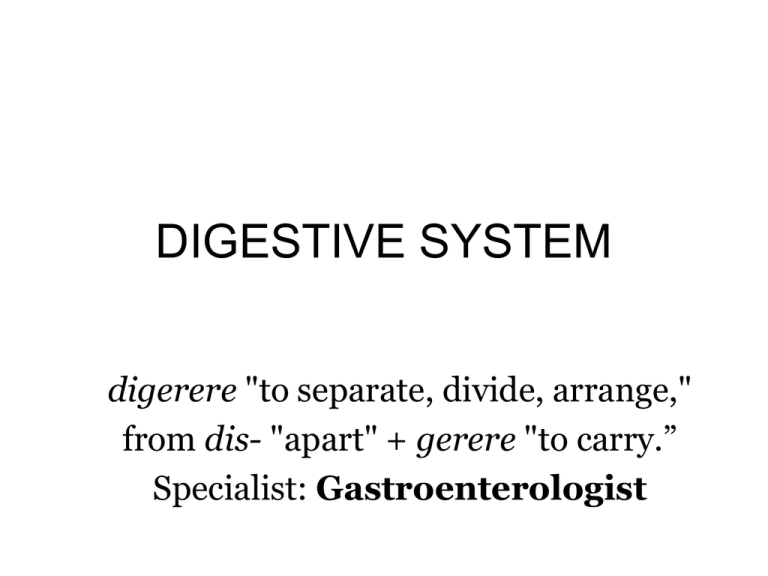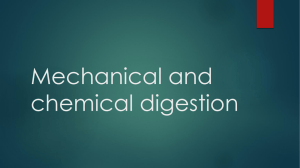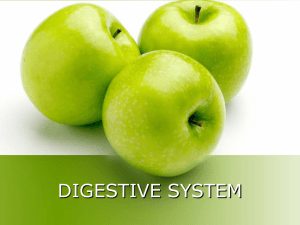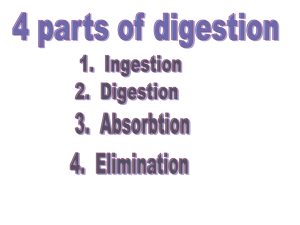File
advertisement

DIGESTIVE SYSTEM digerere "to separate, divide, arrange," from dis- "apart" + gerere "to carry.” Specialist: Gastroenterologist Functions Of The Digestive System • Ingestion: taking food or drink into the mouth • Deglutition: swallowing • *Digestion: breaking down food into molecules that are small enough to enter cells – MECHANICAL DIGESTION • Mixing: alternate contraction and relaxation of smooth muscle in walls of GI tract mixes food with secretions • Propulsion: propelling toward anus ie motility – CHEMICAL DIGESTION • Secretion: cells in GI tract walls secrete ~ 7L water, acid, buffers, digestive enzymes into GI lumen daily • Absorption: products of digestion enter epithelial cells lining GI tract & pass into blood or lymph to circulate to all cells of body • Defecation: substances not absorbed leave body through the anus as feces – wastes, indigestible substances, bacteria, cells sloughed from the GI tract Mechanical vs Chemical Digestion 1. Mechanical digestion – Teeth cut and grind food – Smooth muscle in stomach and small intestine churns food to help it dissolve and mix with enzymes 2. Chemical digestion – Hydrolysis: Water is used to split apart large carbohydrate, lipid, protein, nucleic acid molecules in food. This would take forever w/o: – Digestive enzymes produced by salivary glands, tongue, stomach, pancreas, and small intestines catalyze these catabolic reactions 3. No digestion needed: amino acids, cholesterol, glucose, vitamins, minerals, and water can be absorbed without chemical digestion Mastication, Taste, Salivation, Deglutition MOUTH Mouth (mechanical) – Mastication • During mastication (chewing) food is manipulated by tongue, mixed with saliva, and ground by teeth • 32 permanent teeth grind & cut food: – Incisors: chisel-shaped, cut into food – Cuspids (canines): pointed surface called cusp. tear or shred food – Molars: crush and grind food • food becomes a soft, flexible mass called a BOLUS (lump) that is easily swallowed. Mouth (mechanical) Chewing & Swallowing Buccal (Oral) Cavity • orbicularis oris and buccinator muscles keep food between the upper and lower teeth to assist in chewing Muscles that control the Tongue • Extrinsic muscles: move tongue side to side, in and out. help chew food and push to back of mouth. • Intrinsic muscles: alter shape and size of tongue. help swallow food (& speech) – think rolling the tongue Tongue - Taste • Taste bud receptors are found in: 1. *Fungiform papillae - near tip mushroom-like elevations 2. Foliate papillae – lateral margins of tongue in small trenches 3. (Circum)Vallate papillae - in V-shape area at posterior • Receptors for touch/feel are in: 4. Filiform papillae – (majority of papillae) lack taste buds. • SALIVATION: Taste & Feel of food stimulates salivation. • DIGESTION: Lingual glands secrete mucus, and a watery serous fluid that contains the enzyme, lingual lipase Saliva Functions of Saliva • Lubricates & dissolves food to create a bolus that can be swallowed • Bacteriolytic: Kills bacteria with enzymes like lysozyme • Cleanses mouth & teeth (Saliva continues to be secreted heavily for some time after food is swallowed Secretion of Saliva from: 1. Major salivary glands: Parotid, Submandibular, and Sublingual glands 2. Minor salivary glands: Labial, Buccal, Palatal, Lingual Mouth (chemical): Salivation • Salivation (secretion of saliva) is controlled by the autonomic nervous system: AFFERENT IMPULSES: 1. Food stimulates taste bud receptors on tongue & send sensory info by CN VII / CN IX 2. Impulses from sight, smell, taste are also propagated To salivatory nuclei in brain stem EFFERENT IMPULSES: – Facial (CN VII) & Glossopharyngeal (CN IX) nerves stimulate saliva secretion from major & minor salivary glands – Or sympathetic stimulation FYI Cranial Nerve Review Chemical Digestion in the Mouth • Saliva is 95.5% water, 0.5% solutes. 1. * (ptyalin) salivary amylase. Works optimally at pH 6.8 to digest starch. – Starches are polysaccharides of glucose that exist in 3 forms: ① Amylose (linear): Breaks into maltotriose & maltose ② Amylopectin (branched): breaks into -limit dextrin ③ Glycogen from animals 2. *Contains lingual lipase that activates at pH4 in stomach to digest fat Deglutition = Swallowing • The food bolus stimulates receptors in the oropharynx. • They send signals to the deglutition (swallow) center in the brain stem. • 3 stages of swallowing forcibly moves the bolus from mouth, to esophagus, to stomach by peristalsis. – Buccal stage (Voluntary): bolus is passed into oropharynx – Pharyngeal stage (Involuntary): pharynx > esophagus – Esophageal stage (Involuntary): esophagus > stomach Pharyngeal Phase of Deglutition • Tongue pushes food into the pharynx • Uvula + soft palate rise to close off nasopharynx. Prevents food from entering nasal cavity • Peristalsis is triggered by the bolus contacting the pharynx • The Epiglottis folds down, while Larynx and Hyoid rise, to close off trachea. prevents food from going down trachea Deglutition: Esophageal phase • Upper esophageal sphincter (UES) in laryngopharynx regulates entrance of food bolus into esophagus • Peristalsis: coordinated contractions & relaxations push bolus to stomach • Esophagus secretes mucus but not digestive enzymes • No absorption takes place here • Lower esophageal sphincter (LES) opens during a swallow STOMACH Summary of • Stomach • Functions (2-4 hrs) Reservoir. Holds food. Slowly releases bits to the Small Intestine Mechanical & chemical digestion- makes semisolid food bolus into liquid chyme CHEMICAL DIGESTION OF: 1. Protein: Secretes Pepsin 2. Triglycerides: Gastric lipase & Lingual lipase work here 3. Starch: Salivary amylase continues to work until it contacts acid • Secretes gastrin into blood to stimulate HCl secretion. Hydrochloric acid: – – • • • Kills bacteria Provides an acidic pH for pepsinogen to convert to pepsin Secretes mucus to protect itself Secretes Intrinsic factor – makes B12 absorption possible in Small Intestine Absorbs few substances - H20, aspirin… Mechanical Digestion in the Stomach • A gastric pacemaker in the stomach creates regular depolarizations or ‘slow waves’ (3-5/min) • When stretched by food, signals from stretch receptors increase force & frequency of contractions producing mixing waves which reduce food bolus to soupy liquid called chyme • rippling, peristaltic movements every 15- 25 s macerate food and mix it with secretions from gastric glands Storage in the stomach • stomach can hold up to 4L of food - most distensible organ • A meal can be eaten much faster than the intestines can digest / absorb it • The Fundus serves mainly a distensible storage function. • Rugae disappear when the stomach is distended • Food remains in the stomach for 2-4 hours – Carb meal stays shortest, then protein, fat stays longest Gastric Emptying • each mixing wave forces ~3mL (5ml=1tsp) of chyme through the pyloric sphincter every 15-25 sec • It can take 2-4 hours to empty stomach (more with gastroparesis) • Different foods empty at different rates. Smaller particle size or liquids empty quicker than larger solids. & fat inhibits gastric emptying most potently Chemical digestion of Carbohydrates in the Stomach • Carbohydrate digestion: – Food can remain in fundus without contacting HCl for up to 1hr – Salivary amylase continues to break down starch into maltose maltriose & dextrins until it comes into contact with acidic HCl Chemical digestion of Lipids in the Stomach • 2 lipases that require an acidic pH(3-6) work in the stomach: 1. Lingual lipase activity peaks when bolus contacts stomach acid, HCl 2. Gastric Lipase secreted by Chief cells in fundus • Lipases cleave dietary triglycerides by hydrolysis, resulting in: 1. free fatty acids & 2. diglycerides, or monoglycerides Chemical digestion of Protein in the Stomach • 2 kinds of cells in Gastric glands participate in protein digestion: 1. Chief cells secrete Pepsinogen (inactive enzyme so don’t self-digest) 2. Parietal cells secrete HCl (H+ via H/K proton pump & Cl- separately) • In the presence of HCl (pH 2) or active pepsin, Pepsinogen is activated into pepsin enzyme PEPSIN digests protein into amino acids, NOT HCl • Parietal Cells secrete H+Cl • Parietal cells take up CO2 from the blood • by action of carbonic anhydrase, convert it into Bicarb & H+ ions • The H+ ions are then secreted from ducts of the gastric glands • Bicarb leaves the cell into the blood in exchange for a Clion. This is called the (bicarb) alkaline tide Stomach: B12 & Intrinsic factor 1. 2. 3. 4. • Acid degrades meat, releasing vitamin B-12 (cobalamin) Parietal Cells secrete intrinsic factor In the duodenum, B-12 binds to intrinsic factor Intrinsic Factor shuttles B-12 into the cells of the ileum (B-12 binds to transcobalamin once in the plasma) Stomach: ENDOCRINE Regulation of HCl Increases HCl: Gastrin & Histamine • in the antrum, G cells secrete gastrin into blood, which stimulates: 1. Parietal cell to secrete HCL 2. EnteroChromaffin-Like (ECL) Cells= Mast Cells to secrete histamine. Histamine causes Parietal cells to secrete even more Decreases HCl: Somatostatin • when acid is too high D cells in antrum secrete somatostatin into blood • which inhibits G cell gastrin release into blood Control of Acid Summary Stomach’s Protection from Acid & Enzymes • mucus neck cells & surface mucus cells secrete Mucus & Bicarbonate, HCO3• Pepsin cannot penetrate mucus • H+ can penetrate mucus but it is neutralized by bicarb Controlling gastric emptying, Luminal Pancreatic Enzymes SMALL INTESTINE LUMEN, PANCREAS & GALLBLADDER Small Intestine Functions (3-6 hrs) • Enterogastric reflexes & SI hormones control emptying and acidity of stomach • Alkaline environment due to secretin, Brunner’s glands, & pancreatic bicarb • Most major events of digestion and absorption occur in the small intestine – Pancreatic enzymes, bile, & brush border enzymes complete digestion of carbohydrates, proteins, and lipids – Begins and completes digestion of nucleic acids – Absorption of 90% of nutrients and water through plica, villi, microvilli, lacteals • • • Segmentations mix chyme with digestive juices, bring food into contact with the mucosa for absorption. Peristalsis propels food through the SI. Protects us from external bacteria – Paneth cells, lysozyme, MALT, peyer’s patches • Secretes mucus - goblet cells Small intestine controls Gastric function • When the SI is first distended by chyme, the SI aids gastric digestion by secreting intestinal Gastrin, which stimulates HCl production • If chyme is too acidic or fatty, the SI must slow gastric emptying & decrease HCl production by secreting 1. Cholecystokinin (CCK cells), 2. Secretin (S cells), 3.GIP (K cells) Secreted by the Small Intestine • Endocrine cells of the small intestine secrete: 1. Cholecystokinin (CCK cells) - stimulated by fatty meal. Enters blood and stimulates pancreas to secrete digestive proenzymes & gallbladder to contract & secrete Bile 2. Secretin (S cells) stimulated by acidic chyme. Enters blood & stimulates pancreas to secrete sodium bicarbonate 3. Glucose-dependent Insulinotropic Peptide (K cells) - Stimulates B cells of pancreas to secrete insulin. Glucose ingestion induces release of GIP by SI. Small Intestine Protection from Acid • Small intestine protects its own mucosa from stomach acid entering by the following mechanisms: – Goblet cells secrete MUCUS – Brunner’s glands (B)- large glands secrete alkaline MUCUS – Secretin - recruits pancreas to release alkaline SODIUM BICARB Secretin from Small Intestine stimulates Pancreatic Bicarb • When acidic chyme enters the Small Intestine, the SI releases Secretin into the blood. • Secretin travels via blood to the pancreas & stimulates Duct Cells to secrete alkaline Sodium Bicarbonate (NaHCO3) & H2O with a pH 7.8—9.0 • Alkalinity buffers the acidic chyme, and deactivates the stomach’s pepsin. • Creates the proper pH for digestive enzymes of the small intestine to work CCK from the Small Intestine Stimulates the Pancreas to secrete Digestive Enzymes • CCK from the small intestine stimulates pancreatic Acinar cells (99% of pancreas) to secrete many digestive enzymes & proenzymes activated in the small intestine lumen: – STARCH DIGESTION • Pancreatic amylase – PROTEIN DIGESTION • • • • Tripsinogen Chymotrypsinogen Proelastase Procarboxypeptidase – LIPID DIGESTION • Pancreatic lipase – NUCLEIC ACID DIGESTION • Ribonuclease • Deoxyribonuclease Pancreatic Islets of Langerhans: & cells respond to blood glucose 1% of pancreatic cells are Islets of Langerhans that secrete hormones into the blood (endocrine function of the pancreas): • cells secrete insulin in response to high glucose levels in blood allows cells to absorb glucose via glut transporter proteins • cells secrete glucagon in response to low glucose levels - breaks down glycogen stores in liver SI lumen - Chemical Digestion of Carbs • • Pancreatic -Amylase breaks down carbs - both starch & now glycogen in an alkaline environment Pancreatic -Amylase breaks polysaccharides into: 1. oligosaccharides: maltriose, limit dextrins 2. disaccharides: maltose SI lumen - Chemical Digestion of nucleic acids • Enzymes from the pancreas, Ribonuclease & Deoxyribonuclease, degrade DNA & RNA into nucleotides SI lumen - Chemical Digestion of Protein 1. Pancreas secretes several proenzymes into duodenum in response to CCK 2. Enteropeptidase of duodenum starts the chain reaction, by converting 3. Trypsinogen into Trypsin, which activates other proteolytic proenzymes: – – – Chymotrypsinongen Chymotryopsin Procarboxypeptidase Carboxypeptidase Proelastase Elastase SI lumen- Emulsification of Lipids by Bile salts • *CCK stimulates gallbladder contraction thus Bile / bile salt secretion into SI through duodenal papilla • Bile salts emulsify dietary fats (mainly triglycerides), because they have both hydrophobic & hydrophilic portions (amphipathic). Hydrophobic faces fat side. Hydrophilic faces water side. • Before they can be digested by lipases, lipids must be emulsified into small lipid droplets to increase digestible surface area The liver makes bile • Bile is made in the liver cells, hepatocytes • Bile contains mostly Bile Salts (see pie chart) – Bile salts are made from cholesterol • Bile drains from hepatocytes into bile canaliculi & out ducts Chemical Digestion in SI lumen - Lipids into Micelles • Emulsified fat can be broken down by Pancreatic Lipase into – free fatty acids & – monoglycerides • The Free fatty acids, monoglycerides, & bile salts aggregate into droplets called MICELLES in SI lumen Conversion to monosaccharides, amino acids, and chylomicrons BRUSH BORDER DIGESTION & ABSORPTION Brush Border of the small intestine • Plica circularis folds are covered in projections called villi • Absorptive cells on the villi have microvilli at their apical end • Absorptive cells make enzymes & store them in their microvilli, also known as the “brush border” • Brush border enzymes are the last step in the digestion of carbs, lipids & proteins. After this, the products can be absorbed Brush border digestion & absorption of Carbs • Disaccharides are broken into monosaccharides • brush border enzymes: lactase, maltase, sucrase – Lactose (lactase) galactose + glucose – Maltose (maltase) glucose + glucose – Sucrose (sucrase) glucose + fructose • Monosaccharides can now be absorbed by absorptive cells • Monosaccharides exit absorptive cells from basolateral surface via facilitated diffusion & enter villi capillaries Brush border digestion & absorption of Protein • Brush border enzymes: endopeptidase, aminopeptidase, dipeptidase, tripeptidase complete breakdown of proteins into amino acids • Amino acids, dipeptides and tripeptides can be absorbed via 2° active transport by absorptive cells • Amino acids exit basolateral surface mainly by active transport to enter villus capillary Brush border digestion & absorption of Lipids • Fats from mixed micelles can simply diffuse into absorptive cells • in the smooth ER, long chain fatty acids reassemble into triglycerides • Triglycerides + cholesterol get a protein coat, and are now called chylomicrons. these leave the basolateral surface by exocytosis into a lymphatic lacteal (too big for capillary) Chylomicron • The Protein coat around chylomicrons prevents them from sticking to each other • Lipoprotein lipase secreted by capillaries breaks chylo. down into FA & glycerol again • FA & glycerol can diffuse into hepatocytes or adipose cells • Once inside cells, FA & glycerol again reassemble into triglycerides Digestion summary Absorption in the Small Intestine SI nutrient absorption • Nutrients exit the basolateral surface of absorptive cells into villus capillaries or lacteals – Blood filled with nutrients (proteins & sugars) flows to liver via hepatic portal vein – Chylomicrons dumps into lacteals, travel through the lymphatic system until it dumps into the left subclavian vein & then the The GI tract is a lymphoid organ • Gut Associated Lymphoid Tissue (GALT): – Peyer’s patches - similar to lymph nodes in wall of intestine. B cells (plasma) predominate. Secrete IgA – Lamina propria lymphocytes – Intraepithelial lymphocytes Water absorption in the SI • Nutrients moving from intestinal cells into capillaries create an osmotic gradient for water • Water absorption from the GI occurs via osmosis into capillaries • About 9.3L of water enters the Small Intestine daily from ingested + secreted juices • All except ~1L is reabsorbed in SI Mesentery & Hepatic portal vein • Venous blood from the small intestine, filled with amino acids & monosaccharides, gathers into the superior mesenteric vein and enters the liver through the hepatic portal vein. • Blood vessels to & from the small intestine run through fatty tracts in the mesentery Hepatic blood flow • The hepatic portal vein branches into liver sinusoids • Blood flows from liver sinusoids towards central vein of lobule • Phagocytic Kupffer cells in the sinusoids destroy any bacteria, old WBCs, RBCs… nutrient use in the liver in fed state In the fed state (after a meal): • Carbs: – Glucose is converted to glycogen for storage • Lipids: • Protein – Deamination of amino acids • Deaminated amino acids can be used to make atp, carbs or fats • Toxic ammonia NH3 results • Conversion of ammonia to less toxic urea – Some triglycerides are stored – Lipoprotein transporters are made – Cholesterol is synthesized – Synthesis of plasma – Cholesterol is used to make proteins (globulin, bile salts albumin etc) – Fatty acids are broken down • Vitamins to make ATP – A,D,E,K, B12 are stored – Bile salts are recycled Small intestine Mechanical Digestion • Segmentation - alternating contraction of circular muscle fibers spirals chyme with digestive juice & brings food in contact with mucosa for absorption • Migrating Motility Complex (MMC) - contraction of circular & longitudinal muscle fibers moves chyme from stomach to ileocecal sphincter after most of a meal has been absorbed Enteric Nervous System: a 2nd brain • These neurons can all function independently of the ANS • The Myenteric plexus lies in the muscularis, between longitudinal and circular muscle layers - controls GI tract motility • The Submucosal plexus lies in the submucosa - controls secretory cells of epithelium • Interneurons connect myenteric & submucosal plexi • Sensory neurons are chemoreceptors or stretch receptors LARGE INTESTINE Large Intestine Functions (3-10 hrs) • Haustral churning • Peristalsis/ mass peristalsis • Water absorption • Mucus secretion • Bacterial activity • Defecation reflex Chyme passes ileocecal valve • Chyme passes from the small intestine, ileum, into the large intestine, cecum, through the ileocecal valve • after a meal, secretin relaxes the sphincter • & a gastro-ileal reflex (stomach stretch increases ileal activity) increases ileal peristalsis to push chyme through valve Mechanical digestion in LI • Haustral churning - when 1 haustra fills & distends, it will contract & pass its content to the next one • Peristalsis still occurs here but slowly • Mass peristalsis is triggered by food entering & stretching stomach (gastro-colic reflex). It starts in the middle of the transverse colon, & quickly moves the contents into the rectum Mucus secretion & Water absorption in LI • LI Crypts of Lieberkuhn only have absorptive cells & goblet cells (no other secretory cells): – Absorptive cells absorb all but 100-200mL of water from LI via osmosis (nearly 1L) – Goblet cells secrete mucus to lubricate passage of feces Chemical digestion in LI by Bacteria • Bacteria do the following: – Ferment undigested carbs, releasing methane, H+, CO2 gasses (flatus) – Break down undigested proteins to Amino acids – Break down amino acids to indole & skatole (poop smell), hydrogen sulfide • Some indole & skatole are transported to liver, converted to less toxic substances, then excreted in urine – Synthesize vitamins: Biotin, K. Defecation reflex 1. Mass peristalsis pushes fecal material into rectum 2. Distended stretch receptors in rectum triggers defecation reflex 3. Sensory impulses go to sacrum 4. Parasympathetic motor nerves from sacrum contracts longitudinal muscles & opens involuntary internal smooth muscle sphincter 5. External sphincter can be voluntarily controlled to delay defecation Feces • Feces consist of: – – – – – – – Water Inorganic salts Sloughed off epithelial cells from GI Bacteria (60%) Products of bacterial decomposition Unabsorbed but digested materials Indigestible parts of food eg FIBER: indigestible plant carbohydrates like cellulose, lignin, pectin… • Diarrhea: increased frequency, volume and fluid content due to increased motility and decreased absorption of intestines • Constipation: infrequent or difficult defecation with decreased water content due to decreased intestinal motility









